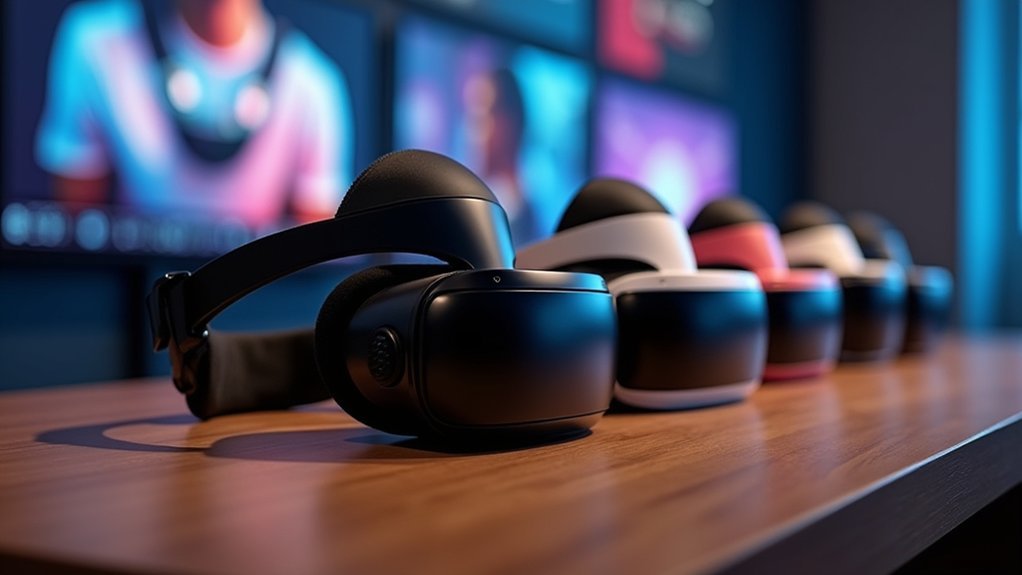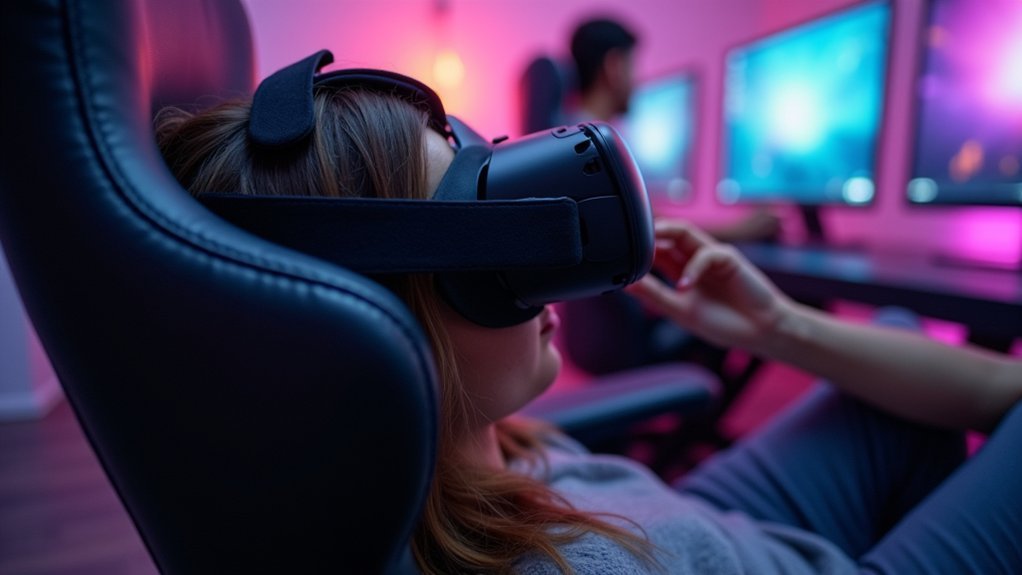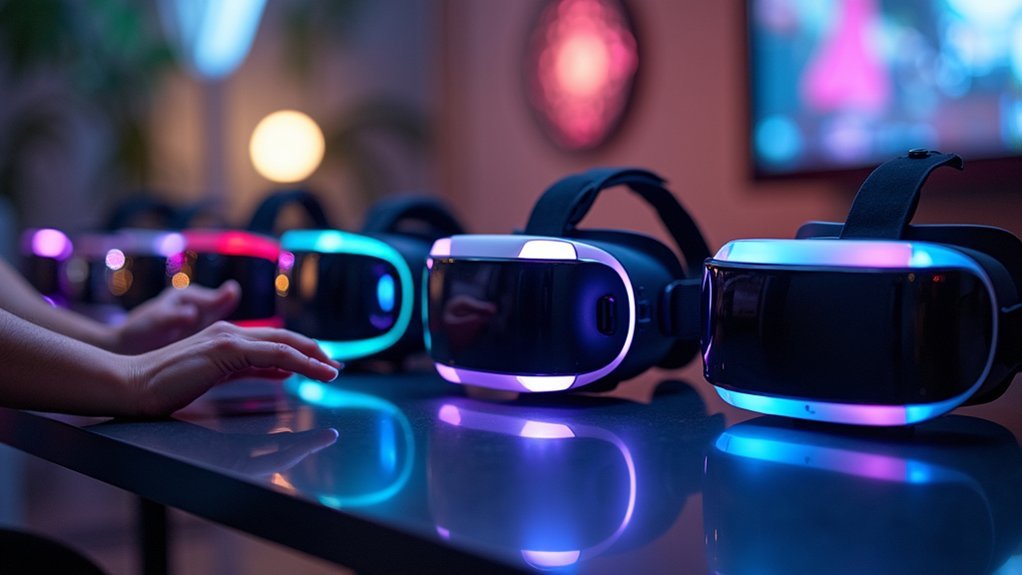When choosing a VR gaming headset, consider your primary needs first. Standalone headsets like Quest 3 offer wireless freedom, while PCVR options deliver better graphics. Look for displays with high resolution (2160×2160 per eye), refresh rates of 90Hz+, and comfortable fit with adjustable IPD. Factor in your budget—prices range from $300 to $1000+—and check platform compatibility for game access. The perfect VR headset balances technical specs with the experiences you value most.
Understanding VR Headset Types and Their Gaming Capabilities

When diving into the world of virtual reality gaming, understanding the different types of VR headsets available is essential to making an informed purchase decision.
You’ll encounter four main categories: standalone, PCVR, console-based, and hybrid headsets. Standalone options like Meta Quest 3 offer wireless freedom and affordability but have less processing power.
Wireless freedom comes at a cost—standalone VR gives mobility but sacrifices the raw graphical power of tethered alternatives.
PCVR headsets such as Valve Index deliver superior graphics but require a powerful computer and cost more. Console-based systems like PlayStation VR2 provide optimized exclusive games but tether you to your console.
Newer hybrid models offer flexibility, functioning both independently and connected to external systems. The PSVR 2 exemplifies this versatility with its recent addition of PC support, expanding its usability beyond PlayStation 5.
Consider what features matter most for your gaming style—advanced tracking, haptic controllers, social capabilities, or specialized options like eye tracking and prescription lens support.
Essential Display and Performance Specifications for Gamers
Why do specifications matter so much when choosing a VR headset? They directly impact your immersion and comfort during gameplay.
Look for high resolution (ideally 2160×2160 per eye) to eliminate the “screen door effect” and a wide FOV (around 120°) for better peripheral vision.
Refresh rates of 90Hz or higher guarantee smooth motion, reducing nausea during intense gaming sessions.
For display types, while LCDs offer good resolution, consider their contrast limitations.
Performance-wise, assess whether you need a standalone headset for convenience or a PCVR model for superior graphics. VRcompare offers a comprehensive database of specifications to help you compare different headset models side by side.
Check latency ratings, tracking precision, and controller responsiveness.
Don’t overlook compatibility with your gaming platform and available content library—these factors will determine what games you can actually play.
Comfort and Ergonomics for Extended Gaming Sessions

Even the most powerful VR headset becomes useless if you can’t wear it comfortably for more than 20 minutes. When selecting your gaming headset, prioritize models with adjustable IPD, cushioned headbands, and breathable materials that prevent overheating during intense sessions. For optimal gaming experiences, look for headsets with high refresh rates of up to 120Hz which significantly enhance smooth VR movement.
| Feature | Benefit | Example |
|---|---|---|
| Adjustable Straps | Customized fit for different head sizes | Meta Quest Pro’s balanced design |
| Lightweight Design | Reduces neck strain during long play | Bigscreen VR’s form factor |
| Cooling Systems | Prevents facial overheating | VIVE Focus Vision ventilation |
| Ergonomic Controllers | Minimizes hand fatigue | PSVR 2’s adaptive triggers |
Consider accessories like elite straps or cooling pads for extended comfort. Hand tracking technology and intuitive gestural interfaces also reduce fatigue by eliminating the need for constant controller use.
Budget Considerations and Value for Money
The vast price range of VR headsets—spanning from $300 to over $1,000—can intimidate newcomers to virtual reality gaming.
VR headsets’ price range—from $300 to over $1,000—creates a daunting entry barrier for virtual reality newcomers.
When evaluating your options, balance features with your budget constraints. The Meta Quest 3S offers impressive value at $299, providing mixed-reality capabilities without requiring a PC or console.
- PSVR2’s recent price drop to $400 makes it an excellent mid-range option with 4K OLED panels.
- Higher-end models like Valve Index ($999+) deliver premium experiences with advanced finger tracking.
- Consider total costs, including space requirements for base stations with high-end systems.
- Mid-range options like Pico 4 Ultra offer a good balance between features and affordability.
- Use comparison tools on sites like VRcompare to evaluate specs across price points.
For casual experiences, the Nintendo Labo Toy-Con 04 offers creative construction with various headset designs for under $100, making it an accessible entry point for families.
Platform Compatibility and Exclusive Gaming Content

When choosing a VR headset, platform compatibility can dramatically impact your gaming options.
PCVR systems like HTC Vive offer extensive game libraries through SteamVR, while the PSVR 2 exclusively connects to PS5 with standout titles like Gran Turismo 7 and Horizon: Call of the Mountain.
If you value flexibility, standalone headsets like Oculus Quest work independently or connected to PCs for enhanced performance. Windows Mixed Reality headsets provide another option, having been specifically developed for Windows 10 and 11 PCs.
For exclusive content, consider that Oculus has its own game library unavailable elsewhere.
Your decision should balance hardware capabilities with content access.
PSVR 2 delivers impressive graphics and advanced controllers with haptic feedback, but lacks the social features found in other platforms.
Meanwhile, PCVR offers the widest game selection but requires a powerful computer and potentially more complex setup.
Frequently Asked Questions
How Long Do VR Headset Batteries Typically Last During Gameplay?
You’ll get about 2-3 hours of gameplay from most VR headsets like the Meta Quest 2. You can extend this to 8+ hours with external battery packs if you’re planning longer sessions.
Can VR Headsets Cause Motion Sickness and How to Prevent It?
Yes, VR headsets can cause motion sickness due to conflicting sensory cues. You’ll prevent it by choosing high-refresh-rate headsets, taking short breaks, starting with seated experiences, and gradually building your VR tolerance over time.
Are VR Gaming Headsets Suitable for Children?
VR headsets aren’t recommended for children under 13 due to developmental concerns. If you’re considering one for your older child, limit sessions to 15 minutes, guarantee supervision, and check manufacturer’s age guidelines first.
How Much Physical Space Is Required for Optimal VR Gaming?
You’ll need at least 2.5 x 2.5 meters for basic room-scale VR, but aim for 6.5 feet by 5 feet for ideal gaming. Don’t forget to add buffer zones and clear all obstacles for safety.
Can Prescription Lenses Be Installed in VR Headsets?
Yes, you can install prescription lenses in most VR headsets. They’re custom-made to match your prescription, eliminating the need to wear glasses while using VR and providing clearer visuals and improved comfort during gameplay.
In Summary
Selecting your perfect VR gaming headset doesn’t need to be overwhelming. By focusing on display quality, performance specs, comfort for those marathon sessions, and compatibility with your preferred gaming platforms, you’ll find a headset that fits both your needs and budget. Remember, the best VR headset isn’t necessarily the most expensive—it’s the one that delivers the immersive gaming experience you’re looking for.





Leave a Reply